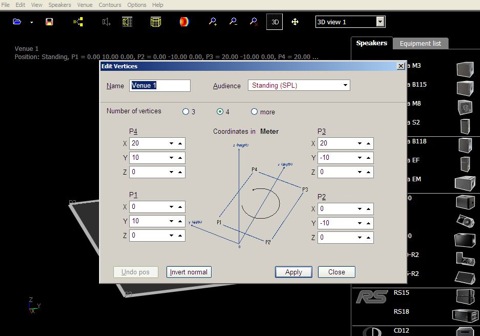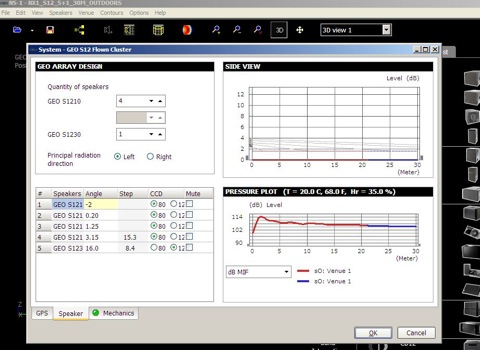Sound System Design
Designing a Nexo Tangent array
13/10/10 11:11 Filed in: Nexo PA Systems
A Note to Professionals: This piece is aimed at the non-professional user in an effort to explain, in layman’s terms, the science and procedure for rigging and tuning a high performance PA system. It is written to show potential clients that there is a difference between the same speaker systems if they are badly designed or deployed. Therefore, there will be some details abbreviated, simplified or omitted for clarity.
Setting up a PA system is easy right? Put the speakers on stands, face them at the audience as you would with your home stereo and you’re good to go, right. Well yes, sort of. The problems arise when you put multiple speakers together in a room in order to cater for larger audiences. If not properly designed, large PA systems can affect tone and clarity as well as having differing tonal characteristics in different parts of a room.
At Alex Fernie Audio, the design of the system begins before we even load the truck. Firstly, the room is measured by a human using a laser measure. We measure the length, width and height of a venue. We measure the width of the stage and the distance from the first line of the audience to the stage. Luckily, over the years we have built up a database of these dimensions for most of the main venues in Ireland, but for new or unfamiliar venues, we look for architectural drawings or send someone to take these measurements for us.
For our Nexo systems, we use Nexo’s proprietary design and prediction software NS-1. Firstly, we tell the program the venue dimensions. As you can see, we work along all 3 dimensions to give a 3-D picture.

As you can see from the picture above, the room we are looking at is a 20 metre by 20 metre square. The Z axis allows us to factor in any slope in the room, to take account of seating banks or balconies. In this room the room is a flat open space.
Next, we open the speaker selection dialogue box and begin adding speakers:

This is the most important part. Here, we not only calculate the quantity and type of speaker we will use, but also the exact position of the speaker in the room (the GPS tab at the bottom) and the angles between each speaker cabinet. On the left of the dialogue box above, we see the speaker type and the various angles between each box. To the right, we see a guide to where each individual speaker is aimed and the lower diagram shows how the speaker system is performing. The basic idea is to design a system which is as loud at the front as it is at the back. This is done for all speaker systems, i.e. left and right and also for the sub-bass cabinets underneath the main PA.
The “mechanics” tab at the bottom of the speaker selection dialogue box ensures that the rigging we are using will be safe and mechanically possible. It tells us how many speakers we will be packing and how heavy the system will be (this is important for the guys rigging the PA on the day) as well as how far it will be above the audience’s heads and so on. As most of our large PA systems are flown on chain hoists from the ceiling of a building, we need to make sure the roof can take the weight. If not we must look at other options such as our own PA lifting towers. For outdoor gigs, we can add in the effect of wind to ensure the system is safe in normal conditions.

Finally, we do a prediction check to see how the system will perform at the day. The software makes a prediction based on average sound levels using pink noise.

This is useful advance information for the system technician on the day when he makes his tweaks to the system on the day. Essentially the coverage is fairly even throughout the venue, however he may decide to angle the speaker arrays as he listens to the system in the room. NS-1 software gives us advance knowledge of potential issues on the day so speeding up the deployment process as well as ensuring we have enough boxes to cover the room.
So there you have it. When you call us up to enquire about a PA system, this is how we work out how many speakers we need, how many people we need to rig the system and ultimately how much it will cost you, the customer.
Setting up a PA system is easy right? Put the speakers on stands, face them at the audience as you would with your home stereo and you’re good to go, right. Well yes, sort of. The problems arise when you put multiple speakers together in a room in order to cater for larger audiences. If not properly designed, large PA systems can affect tone and clarity as well as having differing tonal characteristics in different parts of a room.
At Alex Fernie Audio, the design of the system begins before we even load the truck. Firstly, the room is measured by a human using a laser measure. We measure the length, width and height of a venue. We measure the width of the stage and the distance from the first line of the audience to the stage. Luckily, over the years we have built up a database of these dimensions for most of the main venues in Ireland, but for new or unfamiliar venues, we look for architectural drawings or send someone to take these measurements for us.
For our Nexo systems, we use Nexo’s proprietary design and prediction software NS-1. Firstly, we tell the program the venue dimensions. As you can see, we work along all 3 dimensions to give a 3-D picture.

As you can see from the picture above, the room we are looking at is a 20 metre by 20 metre square. The Z axis allows us to factor in any slope in the room, to take account of seating banks or balconies. In this room the room is a flat open space.
Next, we open the speaker selection dialogue box and begin adding speakers:

This is the most important part. Here, we not only calculate the quantity and type of speaker we will use, but also the exact position of the speaker in the room (the GPS tab at the bottom) and the angles between each speaker cabinet. On the left of the dialogue box above, we see the speaker type and the various angles between each box. To the right, we see a guide to where each individual speaker is aimed and the lower diagram shows how the speaker system is performing. The basic idea is to design a system which is as loud at the front as it is at the back. This is done for all speaker systems, i.e. left and right and also for the sub-bass cabinets underneath the main PA.
The “mechanics” tab at the bottom of the speaker selection dialogue box ensures that the rigging we are using will be safe and mechanically possible. It tells us how many speakers we will be packing and how heavy the system will be (this is important for the guys rigging the PA on the day) as well as how far it will be above the audience’s heads and so on. As most of our large PA systems are flown on chain hoists from the ceiling of a building, we need to make sure the roof can take the weight. If not we must look at other options such as our own PA lifting towers. For outdoor gigs, we can add in the effect of wind to ensure the system is safe in normal conditions.

Finally, we do a prediction check to see how the system will perform at the day. The software makes a prediction based on average sound levels using pink noise.

This is useful advance information for the system technician on the day when he makes his tweaks to the system on the day. Essentially the coverage is fairly even throughout the venue, however he may decide to angle the speaker arrays as he listens to the system in the room. NS-1 software gives us advance knowledge of potential issues on the day so speeding up the deployment process as well as ensuring we have enough boxes to cover the room.
So there you have it. When you call us up to enquire about a PA system, this is how we work out how many speakers we need, how many people we need to rig the system and ultimately how much it will cost you, the customer.
0 Comments

